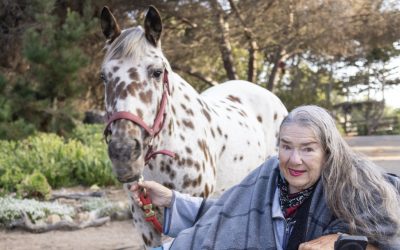They were dark days. The necessity of organization, of intimate relationship, of mutual knowledge and confidence with associates, for self-protection and the good of the public, were apparent to all.” Written in 1883, years after the devastating upheavals of the Civil War, Myron Angel in his vast compilation of the history of San Luis Obispo County touched on the rarely remembered personal consequences of war. Just how did individuals cope with the indescribable anguish of lives lost, futures annihilated, landscapes of devastation, a seismic shift of society and the often-erratic dance of Progress?
No matter the authenticity of research, the skill and talents of the writer, history is mostly moot as to an individual’s desolation after tragedy and leaves the reader’s imagination to recreate the feelings of any moment or event. Thus, as politicians attempted to institute laws to regulate the activities of those governed and, too often, benefit those governing, a fractured and scared Union in the latter half of the nineteenth century struggled to continue, to persevere in the hallow shell of past traditions. In an era of innumerable gatherings of like-minded individuals, many simply created new fraternities often harkening back to real and imaginary panoramas of past glory. A popular answer was for individuals to band together, create codes of conduct, develop splendid and colorful ceremonies and seek to accomplish good deeds and camaraderie for comfort.
The necessity and attraction for the vast network of fraternal organizations—some secret societies—found itself along the central coast as well as in the state and nation. Inclusion also found recognition for the ladies. For some clerks in the growing bureaucracy of Washington, D. C, the benefits of societal interaction created a flourishing organization. While no longer active locally, the Knights of Pythias deserve remembrance as having contributed to the integrity of the recent past.
Here’s the story:
Founded in the nation’s capital on February 19, 1864, Knights of Pythias was the first fraternal organization to receive a Congressional charter and was recognized by President Abraham Lincoln who lauded the organization. “If we could but bring its spirit to all our citizenry,” he wrote of their creed after the Civil War, “what a wonderful thing it would be…” The healing he had envisioned continues to this day. The name was inspired by the pre-Christian legend of Damon and Pythias. In a tale of loyalty, friendship and honor, the two were willing to sacrifice their lives for each other.
The legend’s message at the center of the order’s motto of justitia et fidelitas (justice and faithfulness) would reach hundreds of thousands of members. With the first charter granted in San Francisco and eventual lodges (referred to as castles) in all counties, the local chapter was established on December 21, 1876 as Park Lodge #40. By then, total knights numbered about 150,000. Other local chapters were formed in Paso Robles, Arroyo Grande and Nipomo.
The letters emblazoned on its emblem “FCB”— Friendship, Charity, Benevolence—are the keystone goals of any lodge and its members. The highest achievement for each is “to speak the truth and to render benefits to each other.” Replicating the often-ornate ceremonies and regalia of times gone by, the fundamentals of the organization harken back to the timeless virtues of “nobility in deed, fraternity in actions and community stability.”
As it evolved, many members were also enrolled in other fraternal organizations holding similar beliefs and goals. Possibly a pioneer method of “networking,” the membership was a reservoir of business and community leaders whose objective was to aid one another in time of need. For example, when a member became ill, weekly funds were made available along with members who must “sit and watch by him at night and during the day if necessary.” Upon the death of a member, money was given to defray burial costs. It was a requirement that every member was obligated to accept so there would be no taint of receiving charity. There was also an insurance program allowing death benefits of one or two thousand dollars. All members contributed to the fund. In a lengthy address given locally in its early days, another benefit outlined was the “insurance endowment.” It had been severely tested by an epidemic of yellow fever but survived as all had contributed an extra amount to meet its obligations to the deceased. Eventually, this would become a separate corporation.
For the Pythians, by the end of the so-called “Golden Age of Fraternalism” in the early 1920s, the order had nearly a million members. Its numbers have declined considerably over the years but not its chartered creed. A Pythian oath summarizes the ideal for each member that he is “not a professional gambler,” doesn’t engage in illegal sale of alcohol or drugs and supports the “maintenance of the order and the upholding of constituted authority.” Politically, he is not a Communist or Fascist; nor does he “advocate the overthrow of…Government” nor “seek by force or violence to deny to other persons their rights under the laws.” Across America today, active lodges continue in a variety of programs and pledges to fulfill their oath.
There are many more examples of the kindness and compassion from the past deserving remembrance. Ending his historical compilation in the early 1880s, Angel remembers the Patrons of Husbandry or the Grange, Order of Good Samaritans, Sons of Temperance, American Legion of Honor, the Independent Order of Missourians, the Agricultural Society, Society of Pioneers, Temperance and Life Insurance, Order of Chosen Friends, and the Irish Land League. Most would cease operations locally while others—to this day—with less ornate ceremonies seek to reach beyond personal needs to address those of others. Each enriched and enriches humanity as well as participants.
Seemingly less newsworthy than much of the contemporary world, who can deny they are the more essential expression of the innate compassion of the human spirit?





